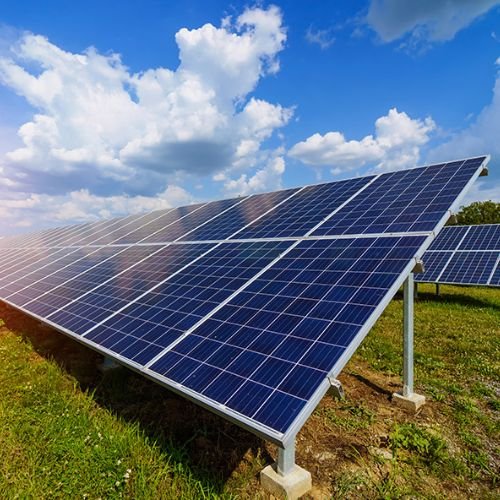Ground Mounted
Solar PV System
A ground-mounted solar photovoltaic (PV) system is a type of renewable energy infrastructure that harnesses sunlight to generate electricity. Unlike rooftop solar panels, which are installed on buildings, ground-mounted systems are erected on the ground, typically in open areas such as fields, meadows, or unused land. These systems consist of solar panels, mounting structures, inverters, wiring, and sometimes tracking systems.
Components of a Ground-Mounted Solar PV System:
- Solar Panels: The heart of the system, solar panels are composed of photovoltaic cells that convert sunlight into direct current (DC) electricity through the photovoltaic effect.
- Mounting Structures: These support the solar panels and keep them elevated above the ground at an optimal angle for sunlight exposure. Mounting structures can be fixed or adjustable depending on the specific needs of the installation.
- Inverters: Solar inverters convert the DC electricity generated by the solar panels into alternating current (AC) electricity, which is compatible with the electrical grid and most appliances.
- Wiring and Electrical Components: Wires, junction boxes, and other electrical components are necessary to connect the solar panels, inverters, and other system elements together safely and efficiently.
- Grounding Equipment: Grounding ensures the safety of the system by providing a path for electrical currents to dissipate harmlessly into the ground in the event of a fault or surge.
- Tracking Systems (Optional): Some ground-mounted systems incorporate solar tracking technology, which adjusts the angle and orientation of the solar panels throughout the day to maximize sunlight exposure and energy generation.
Advantages of Ground-Mounted Solar PV Systems:
- Optimal Sunlight Exposure: Ground-mounted systems can be strategically positioned to capture maximum sunlight throughout the day, optimizing energy production compared to rooftop installations that may be subject to shading or orientation limitations.
- Scalability: Ground-mounted systems can be scaled up more easily than rooftop installations, making them suitable for large-scale commercial or utility-scale projects.
- Maintenance Accessibility: With ground-mounted systems, maintenance and cleaning of the solar panels are typically easier and safer compared to rooftop installations, as they are easily accessible from the ground.
- Flexibility in Location: Ground-mounted systems can be installed on a wide range of terrains, including uneven or sloped surfaces, and can be situated on sites not suitable for building-mounted solar panels.
- No Structural Limitations: Unlike rooftop installations, ground-mounted systems do not rely on the structural integrity of buildings, making them suitable for areas prone to high winds, heavy snow loads, or seismic activity.
- Land Utilization: Ground-mounted solar systems can utilize otherwise unused or marginal land, providing additional benefits such as soil conservation, biodiversity preservation, and potential dual land use (e.g., agriculture combined with solar energy production).


